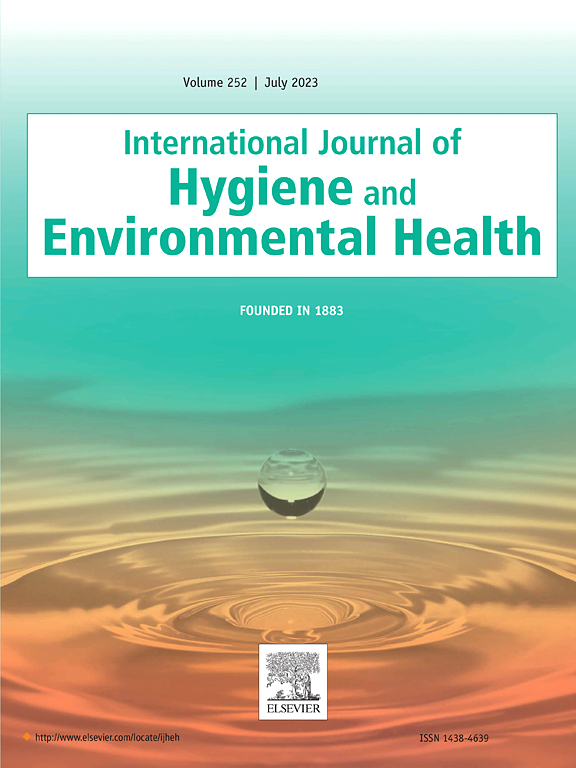Environmental exposure to polychlorinated dibenzo-p-dioxins and dibenzofurans among population living in a contaminated area in Lausanne, Switzerland
IF 4.5
2区 医学
Q1 INFECTIOUS DISEASES
International journal of hygiene and environmental health
Pub Date : 2025-07-01
DOI:10.1016/j.ijheh.2025.114619
引用次数: 0
Abstract
Polychlorinated dibenzo-p-dioxins and dibenzofurans (PCDD/Fs) are ubiquitous in the environment and the main route of exposure for humans is food. A widespread soil contamination was discovered in 2021 in Lausanne city. Previous human exposure assessment study showed that consumption of home-produced eggs and cucurbits were dominant exposure scenarios. In the absence of recent biomonitoring data on PCDD/Fs in the Swiss general population, we conducted a cross-sectional study in 2023 to assess the difference between control (n = 50) and exposed (n = 51) groups, living in the contaminated area and reporting to consume selected home-produced foods (eggs and cucurbits). We compared the two groups using multivariable modelling. The geometric mean serum PCDD/Fs concentration was 6.1 (Interquartile range (IQR): 4.2) and 6.9 (IQR: 5.0) pg TEQ05/g lipid in the control and exposed groups, respectively. In the exposed group, the serum concentrations were 7.7 (IQR: 4.6) and 6.4 (IQR: 3.8) pg TEQ05/g lipid for those who consumed home-produced eggs or cucurbit, respectively. In unadjusted analysis, control and exposed groups did not significantly differ. However, multivariable analyses showed that older age, female sex, higher body fat mass and consumption of home-produced eggs from contaminated areas were independently and significantly associated with higher PCDD/F concentrations. Health risk for humans living on contaminated areas depends on the land use. These results confirm the importance of dietary factors of animal origin as an important route of PCDD/Fs exposure. Unlike cucurbits, home-produced eggs from contaminated areas represent an important source of exposure to PCDD/Fs, which helps guiding public health recommendations.

生活在瑞士洛桑污染地区的人口对多氯二苯并-对二恶英和二苯并呋喃的环境暴露
多氯二苯并对二恶英和二苯并呋喃(PCDD/Fs)在环境中普遍存在,人类的主要接触途径是食物。2021年,洛桑市发现了大面积的土壤污染。以往的人类暴露评估研究表明,食用国产鸡蛋和葫芦是主要的暴露情景。由于缺乏瑞士普通人群中PCDD/Fs的近期生物监测数据,我们于2023年进行了一项横断面研究,以评估控制(n = 50)和暴露(n = 51)组之间的差异,这些组生活在受污染地区,并报告食用选定的家产食品(鸡蛋和瓜类)。我们使用多变量模型对两组进行比较。对照组和暴露组的几何平均血清PCDD/Fs浓度分别为6.1(四分位间距(IQR): 4.2)和6.9 (IQR: 5.0) pg TEQ05/g脂质。在暴露组中,食用自制鸡蛋或葫芦的人的血清浓度分别为7.7 (IQR: 4.6)和6.4 (IQR: 3.8) pg TEQ05/g脂质。在未调整分析中,对照组和暴露组没有显著差异。然而,多变量分析表明,年龄较大、女性、较高的体脂量和食用来自污染地区的自制鸡蛋与较高的PCDD/F浓度独立且显著相关。生活在受污染地区的人的健康风险取决于土地的使用。这些结果证实了动物源性饮食因素作为PCDD/Fs暴露的重要途径的重要性。与葫芦不同,来自受污染地区的自制鸡蛋是接触PCDD/Fs的重要来源,这有助于指导公共卫生建议。
本文章由计算机程序翻译,如有差异,请以英文原文为准。
求助全文
约1分钟内获得全文
求助全文
来源期刊
CiteScore
11.50
自引率
5.00%
发文量
151
审稿时长
22 days
期刊介绍:
The International Journal of Hygiene and Environmental Health serves as a multidisciplinary forum for original reports on exposure assessment and the reactions to and consequences of human exposure to the biological, chemical, and physical environment. Research reports, short communications, reviews, scientific comments, technical notes, and editorials will be peer-reviewed before acceptance for publication. Priority will be given to articles on epidemiological aspects of environmental toxicology, health risk assessments, susceptible (sub) populations, sanitation and clean water, human biomonitoring, environmental medicine, and public health aspects of exposure-related outcomes.

 求助内容:
求助内容: 应助结果提醒方式:
应助结果提醒方式:


